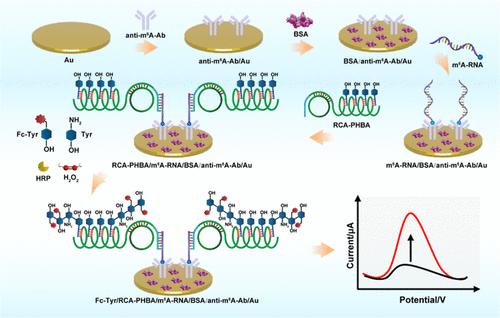Our official English website, www.x-mol.net, welcomes your
feedback! (Note: you will need to create a separate account there.)
Ultrasensitive Biosensors Detecting m6A in Blood: Achieving Early Screening and Typing of Tumors
ACS Sensors ( IF 8.2 ) Pub Date : 2024-10-29 , DOI: 10.1021/acssensors.4c01875 Haiping Li, Xixiang Xie, Xiyu Liu, Pan Wu, Jian He, Faquan Lin, Liang Shi, Yong Huang
ACS Sensors ( IF 8.2 ) Pub Date : 2024-10-29 , DOI: 10.1021/acssensors.4c01875 Haiping Li, Xixiang Xie, Xiyu Liu, Pan Wu, Jian He, Faquan Lin, Liang Shi, Yong Huang

|
N6-methyladenosine (m6A) modification is one of the most widespread RNA modifications in eukaryotes and is involved in cancer development and progression by regulating oncogene expression. Herein, a reticulated rolling circle amplification (RCA) cascade reaction was used to construct a novel electrochemical biosensor for ultrasensitive detection of m6A, employing ferrocene-tyramine (Fc-Tyr) molecules as electroactive probes. In this strategy, the RCA cascade reaction not only amplifies specific circular DNA in the designed template to reduce the binding with similar nucleic acid sequences but also generates a long ssDNA through multiple repetitions to capture a large number of electrochemical signal probes and achieve the amplification of electrochemical biosensing signals. The developed biosensor demonstrated high selectivity and sensitivity toward m6A in the range of 0.5 pM-150 nM, with a detection limit of 14.07 fM. Meanwhile, total RNA extracted from cell samples was analyzed for m6A expression levels using the developed biosensor and a commercial colorimetric immunoassay, the biosensor and immunoassay showed consistent results. In addition, m6A levels in clinical serum samples were assessed using the developed electrochemical biosensor, which showed that m6A expression was much lower in healthy individuals than in cancer patients, therefore the biosensor is promising for cancer typing. This study provides a new method for rapid and convenient tumor marker detection in clinical practice, as well as a new idea for sensitive detection of other biomolecules.
中文翻译:

检测血液中 m6A 的超灵敏生物传感器:实现肿瘤的早期筛查和分型
N6-甲基腺苷 (m6A) 修饰是真核生物中最广泛的 RNA 修饰之一,通过调节癌基因表达参与癌症的发生和进展。在此,采用网状滚圆扩增 (RCA) 级联反应构建了一种新型电化学生物传感器,用于对 m6A 进行超灵敏检测,采用二茂铁-酪胺 (Fc-Tyr) 分子作为电活性探针。在该策略中,RCA 级联反应不仅扩增设计模板中的特异性环状 DNA 以减少与相似核酸序列的结合,而且通过多次重复生成长 ssDNA,以捕获大量电化学信号探针,实现电化学生物传感信号的放大。开发的生物传感器在 0.5 pM-150 nM 范围内对 m6A 表现出高选择性和灵敏度,检测限为 14.07 fM。同时,使用开发的生物传感器和商用比色免疫测定法分析从细胞样品中提取的总 RNA 的 m6A 表达水平,生物传感器和免疫测定显示出一致的结果。此外,使用开发的电化学生物传感器评估了临床血清样本中的 m6A 水平,结果表明健康个体的 m6A 表达远低于癌症患者,因此该生物传感器有望用于癌症分型。本研究为临床实践中快速便捷的肿瘤标志物检测提供了一种新方法,也为灵敏检测其他生物分子提供了新思路。
更新日期:2024-10-29
中文翻译:

检测血液中 m6A 的超灵敏生物传感器:实现肿瘤的早期筛查和分型
N6-甲基腺苷 (m6A) 修饰是真核生物中最广泛的 RNA 修饰之一,通过调节癌基因表达参与癌症的发生和进展。在此,采用网状滚圆扩增 (RCA) 级联反应构建了一种新型电化学生物传感器,用于对 m6A 进行超灵敏检测,采用二茂铁-酪胺 (Fc-Tyr) 分子作为电活性探针。在该策略中,RCA 级联反应不仅扩增设计模板中的特异性环状 DNA 以减少与相似核酸序列的结合,而且通过多次重复生成长 ssDNA,以捕获大量电化学信号探针,实现电化学生物传感信号的放大。开发的生物传感器在 0.5 pM-150 nM 范围内对 m6A 表现出高选择性和灵敏度,检测限为 14.07 fM。同时,使用开发的生物传感器和商用比色免疫测定法分析从细胞样品中提取的总 RNA 的 m6A 表达水平,生物传感器和免疫测定显示出一致的结果。此外,使用开发的电化学生物传感器评估了临床血清样本中的 m6A 水平,结果表明健康个体的 m6A 表达远低于癌症患者,因此该生物传感器有望用于癌症分型。本研究为临床实践中快速便捷的肿瘤标志物检测提供了一种新方法,也为灵敏检测其他生物分子提供了新思路。


















































 京公网安备 11010802027423号
京公网安备 11010802027423号